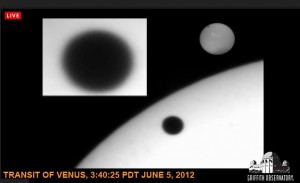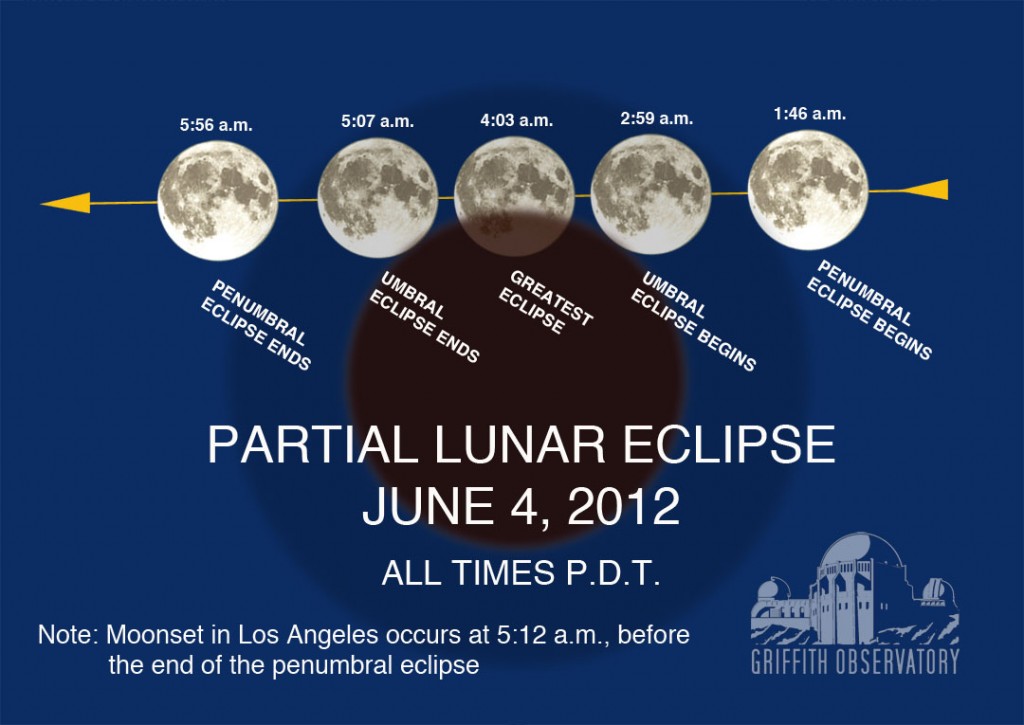![]() LISTEN to this week’s Sky Report
LISTEN to this week’s Sky Report
(below, right: Transit of Venus as photographed through Griffith Observatory’s telescopes on June, 5, 2012) Please click here to view video of the event.

This is the Griffith Observatory Sky Report for the week ending Wednesday, June 6, 2012. Here is what’s happening in the skies of Southern California:
The first transit of Venus visible from Los Angeles since December 10, 1882 will happen on Tuesday afternoon, June 5. A transit happens when Venus passes directly between the earth and the sun, a rare occurrence due to the 3.4-degree tilt of Venus’s orbit relative to ours. From Los Angeles, Venus makes first contact with the sun at 3:06 p.m., P.D.T. The planet will take nearly 18 minutes for its silhouette to completely enter the sun’s disk. Venus comes to within 9.2 arc minutes of the center of the sun’s disk, roughly midway between the center of the disk of the sun and its northern (upper right) edge, at 6:25 p.m. The sun sets at 8:02 p.m. with the transit about one hour, 45 minutes from completion.
The same caution used for observing sunspots and solar eclipses is needed in order to see the transit. Safe solar eclipse glasses and viewers will show the planet as a distinct black spot. These viewers are expected to be on sale at Griffith Observatory’s store, the Stellar Emporium, by this weekend. Do not use methods or materials that are not especially approved for viewing the sun. Material that merely darkens the sun the required 100,000 times may do little or nothing to lessen invisible ultra-violet or infrared radiation that can painlessly and irreversibly damage your vision.
Griffith Observatory will provide free public Venus transit viewing with safely equipped Observatory telescopes. These telescopes will be joined by the Observatory approved telescopes of local astronomy societies. Please note that the general public may not bring telescopes to the Observatory grounds at any time, and enforcement will be particularly strict at this event. The Observatory will be open from Noon until 10 p.m., and the transit is visible from 3:06 p.m. until 8:02 p.m. Please check our website and special Venus Transit page for additional details.
Please note that the only thing on earth rarer than a transit of Venus is a parking spot close to Griffith Observatory during a transit of Venus, so please be prepared to arrive early and ready for a hike! If you miss the transit, however, there will be another one visible shortly before sunset on December 10, 2117!
The full moon will pass through the northern edge of earth’s shadow, producing a partial eclipse of the moon on Monday morning, June 4. The moon reaches the outermost, fuzzy edge of earth’s shadow, the penumbra, at 1:48 a.m., but will not be deep enough into the shadow for any hint of darkening until about 2:30.m. A distinct bite out of the southeast (left) limb of the moon will appear when it crosses the earth’s dark inner shadow (umbra) at 2:59 a.m. Mid eclipse happens at 4:03 a.m. At that time, 38 percent of the moon’s diameter will be within the umbra. A view through a telescope or binoculars may show the umbra-covered portion of moon faintly, possibly with a coppery or red hue due to sunlight bent and filtered by earth’s atmosphere, but the shallowness of the eclipse will make this observation difficult. The moon exits the umbra during the dawn, at 5:07 a.m. while 7 degrees high in the west-southwest. The moon sets at 5:56 a.m., 24 minutes before it completely exits the penumbra. Griffith Observatory will not be open for this event.
Planet Mars, in Leo the Lion, and planet Saturn, near Virgo the Maiden’s bright star Spica are best seen in the early evening. Saturn and its rings are featured through Griffith Observatory’s public telescopes.
The historic test flight of the SpaceX Dragon, the first commercial cargo mission to the International Space Station, is scheduled to end on Thursday morning, May 31. The release of the automated Dragon capsule from the ISS should occur at at 3:10 a.m., P.D.T. then return to earth in the Pacific Ocean off the coast of Baja California less than 5 hours later. Live coverage will be provided on NASA TV, available at www.nasa.gov.
Check our website for information about free public telescope viewing of the sun and nighttime celestial objects at Griffith Observatory.
From Griffith Observatory, I’m Anthony Cook, and I can be reached at griffithobserver@gmail.com.
